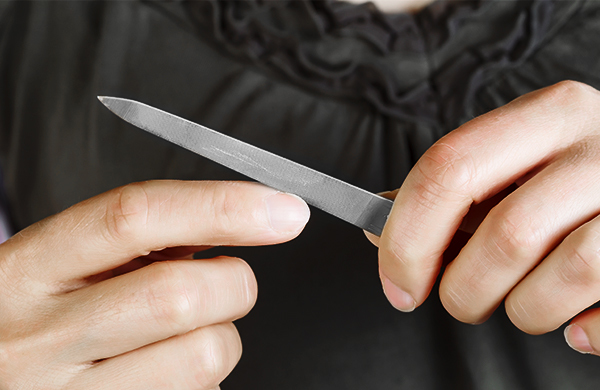
What's the difference between emery boards and metal nail files? Should you use a buffing block or a glass nail file? And what does grit value even mean? Unlike getting your nails done at a nail salon, where you can tune out and let the technician do their thing, at-home maintenance requires a bit more finesse.
Choosing the best nail file for your needs can prevent unnecessary damage, breakage, and even chipped nails. And with so many options to choose from, it can be easy to feel overwhelmed—especially when manicure tools hold the potential to literally make or break your nails. Read along to determine which at-home manicure tools are best suited for you.
Types of nail files

Emery boards
Emery boards are what most people picture when they hear the words "nail file," as they are the most common type of file. They have a more basic design than other nail files, but are very effective, making them some of the best nail files around. These dual-sided tools usually have two different grit values (see below for more in grit) on each side, which means they can be used for basic shaping and filing needs without being overly abrasive.
Check out these deals on emery boards:

Metal nail files
Metal nail files tend to have a really low grit value, which is why they generally aren't recommended for use on natural nails. Due to their abrasive and harsh ground-metal composition, they can cause splintering in natural nails. They do, however, work really well on acrylic, gel, and other artificial nails.

Glass nail files
Made of ground-up crystals, glass files (a.k.a. crystal nail files) have a fine grit that is gentle on natural nails but still strong enough for artificial nails. These tools work well for a variety of different functions thanks to the precision detailing they provide. Glass files are not only great for refining and shaping nails, but also for cleaning up edges and smoothing bumps on the nail's surface.
Check out these great deals on glass nail files:

Ceramic nail files
If you have soft or weak nails, then fret no longer because ceramic nail files are the answer to your manicure woes. They are gentle on natural nails, and they help seal in the edges of nails as you file them, making them the best nail file for reducing splitting and breakage.

Buffing blocks
These colorful all-in-one tools feature all of the essentials needed for an at-home manicure. Four-sided blocks have different grits on each side, so each side has its own purpose: shaping, removing ridges, smoothing, and adding shine. No need to worry if you're an at-home manicure novice because each side of the block is usually labeled with its function and/or a number to let you know which order to use it in.
Check out these great deals on buffing blocks:
What's the deal with nail grit?
Another important thing you need to know about nail files is the grit value. Just like sandpaper, a nail file's abrasiveness is determined according to a scale. The rule of thumb to remember is that the lower the grit value, the coarser the file will be.
The Four Basic Grits Used in Salons
- Coarse (100 grit or less): ideal for shaping acrylics
- Medium (180–220 grit): ideal for shaping and smoothing artificial nails and shaping natural nails, particularly toenails
- Fine (240–600 grit): ideal for shaping and finishing natural nails
- Ultrafine/buffer (600 grit and above): buffs and shines the nail surface

Check out what else you need for an at-home manicure with our guide to must-have nail-art tools.

This article was originally written by Anam Ather. It has since been updated.